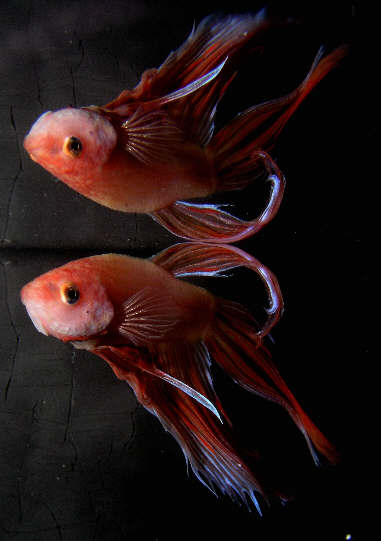

 What most people don’t realize is that during the rainy season, the rice paddies are flooded. As the seasons change the water gradually dries into the small puddles the fish then survive in. They don’t live in puddles ALL the time. The factors that most effect the health of these fish in captivity are temperature and stress. The part of the world where the fish come from is hot and the water temperature can get over 80 degrees. Vegetation is heavy and the fish like to hide in the plants for security. In a small bowl of water in the cooler parts of the United States, the water temperature can range from 55 to 70 degrees. If the fish is too cold, it won’t eat and will grow weaker. If the fish is kept in an open bowl (no hiding spots) it is likely to be stressed. As the temperature drops and stress increases the fishes immune system doesn’t function at full capability and the likeliness of secondary problems such as bacterial and fungal infections goes up. Once they set in, medications are not always successful because the conditions that caused the problems remain. While some fish may live for years like this, it is really surviving. Pet Stores offers a variety of one and two gallon aquariums that have a cover with a light. They are often marketed incorrectly for goldfish but are much more appropriate for a fish that breathes from the surface. The light provides a basking area where the fish can raise its body temperature in order to remain healthy and colorful and allows you to see the fish. You will need a 5 pound bag of aquarium gravel and at least one artificial plant. The silk plants are softer than the plastic plants once wet and are less likely to tear the fins or damage the slime coat. Use bottled water to fill the container and add the correct amount of aquarium salt. Put about two inches of gravel in the tank and rinse it gently in the sink. Place the plant in the center and cover the base with the gravel. The first time you fill your container, use the bottled water designed for betta bowls and add a half a tea spoon of the aquarium salt. Refill the water container from your sink and add the same amount of salt and leave it till next week when you change the water. Once your container if full pour out half of the water out of the cup that you bring the fish home in, and replace it with water from the tank (spring water). Let it sit for about 10 minutes, and pour half of the water out again. Fill it again from the tank only this time, allow the fish to swim out of the cup and into the tank. Save the cup and use it to remove the fish for future water changes. If you have a one gallon container with an undergravel filter you are better off just not even using the filter at all and doing total water changes. The fish don't really like all the extra bubble activity. By doing weekly total water changes you will disrupt the biological activity that turns fish waste into food for algae. This will allow you to keep the light on all night to help keep the fish warm and provide a child with a wonderful night light, without it turning green with algae. If you have the two gallon set up with a decent filter you can do partial water changes to establish biological filtration. Every other week, siphon 20% of the water from the bottom of the tank (gently stirring the gravel), into a bucket and replace it with water left out to sit like described above. Replace any water that evaporates on a weekly basis. Turning the light off at night and adding a snail will help keep algae under control. There are some attractive species of snail that can add a little life to the tank and help with the cleaning. If algae starts to take over the tank, just start from scratch. You can create a wonderful and healthy world for one of these beautiful fish in just a gallon of water for around 20 dollars. Some of the containers that they market for them are only suited to hold loose change. Don't make them survive. Let them live. |

 |
Home |